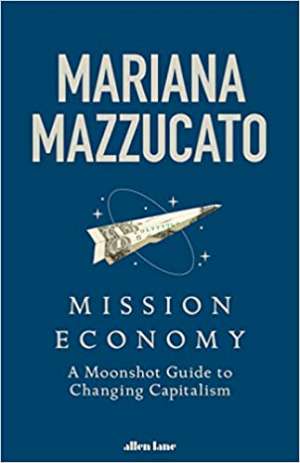08 March 2021
Mission Economy
A Moonshot Guide to Changing Capitalism
Mariana Mazzucato
Allen Lane, 272 pages,
ISBN 9780241419731
Reviewer: Bridget Rosewell

I approached this book with considerable interest. Professor Mazzucato has an enviable reputation for thinking about innovation systems and is heavily engaged in policy making. Her views on how to change capitalism should be worth reading.
I was disappointed. There are some good ideas in the book but to me they felt scattered and unfocused and lacked a sufficiently strong analytical background. What is the capitalism that is in crisis? Mazzucato refers to finance investing in finance, to short termism, inequality and insecurity. All familiar tropes but how do they fit together? Inequality and insecurity have been facts of human life for millennia and so she needs to show what the modern specifics are. Moreover, her position is one-sided. She asserts that the Covid-19 crisis revealed just how fragile capitalism really is. Yes and no. It also revealed how flexible capitalism is in altering supply chains, developing and delivering vaccines. It blunders, but it also recovers. There is an important debate to be had about managing resilience in the face of uncertainty and keeping costs under control at the same time. This book’s answer is simplistic – we need more government.
At one level, the discussion of how governments shape markets, rather than simply address market failures is useful. But to get focus we need to consider what is meant by government. Our civil servants are, as she says ‘brilliant’ but they are not suited to all forms of governance or government. Should we be talking about Whitehall, about international bodies, about regulators, or maybe local government, regions and bottom up professional organisations? You simply cannot talk about just ‘government’. And policy made without regard to practicality, deliverability or how to write contracts easily comes unstuck.
There are classic examples, such as the Child Support Agency where expensive systems could not cope with the fact that many cases were inter-related, through to an inability to understand that delivering MOTs to an additional 30,000 vehicles could not be done in a few weeks. Government does indeed shape markets, not always well. It requires an assessment of how this can be done sensibly.
The “moonshot” of the title leads to a description of how to create a mission – man on the moon by 1969 – and of the project management skills which were then brought to bear, alongside an attack on outsourcing and the credos of New Public Management. What I found most interesting here is that much of this repeats lessons that we keep failing to learn. Large projects are fraught with difficulty, and run over budget, as did the moon programme. Finding the right people and the right skills to run them and to build the range of partnerships necessary for success is hard. Being an intelligent client is extremely difficult but trying to do everything in-house is equally challenging. Perhaps the reason we fail to learn the lessons of project and programme management is that they present themselves in different guises each time. Or perhaps there simply aren’t many people who can transmit such lessons across projects. It can’t be done with checklists and pages and pages of papers. It is done in real time and in the face of multitudinous challenges. Genuine, hands-on experts needed!
Which brings me to the matter of defining the “mission”. There is much discussion, for example, among economic regulators of defining outcomes, rather than outputs or inputs, as the objectives required of utility companies. Sounds more like a mission, doesn’t it? For example, treating customers fairly might be an outcome objective. In comparison with ‘put a man on the moon before the end of the decade’, however, it is woolly and hard to define. Indeed, reasonable people can disagree about what it means. So surely defining the mission is as important as mapping the impacts on it. The missions set out in this book are, in my view, a bit of a mixture. One is 90% reduction of plastic entering the oceans and a 50% reduction in the amount of plastic by 2025. That’s precise and clear and is an output. On the other hand the mission to halve the burden of human dementia by 2035 is much harder to pin down. How many missions can one society have?
Mazzucato is right to argue that a successful economy needs a mix of actors and organisations and that public policy shapes the way in organisations can behave. She is right that the interplay between policy makers and operators within policy is dynamic and shifting and that partnerships across organisations and bringing in the widest variety of skills are crucial. There are a lot of good points in here. I just wish they were better put together.
